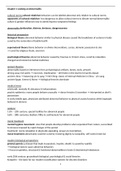Chapter 1 Looking at Abnormality
cultural norms cultural relativism behaviors can be labeled abnormal only relative to cultural norms
opponents of cultural relativism ‘too dangerous to allow cultural norms to dictate normal/abnormality
culture & gender influences way to admit/express symptoms/feelings
abnormality dysfunction, distress, deviance, dangerousness
historical perspective
biological theory abnormal behavior similar to physical disease caused the breakdown of systems in body
cured by the restoration of bodily health
supernatural theory blame behavior on divine interventions, curses, demonic possession & sins
→ cured by religious rituals, exorcism
psychological theories abnormal behavior caused by traumas or chronic stress, cured by relaxation,
changed environment & herbal medicines
ancient theories
abnormality based on inferences from archaeological artifacts, bones, tools, artwork
driving away evil spirits → exorcism, trephination – drill holes in the skull to let spirits depart
ancient china → balancing yin & yang → Nei Ching: classic of Internal Medicine in China – yin yang
ancient Egypt, Greece & Rome → biological theories dominate
medical views
witchcraft: mentally ill, delusions & hallucinations
psychic epidemics: many people behave unusually → dance frenzies & tarantism → interpreted as devil’s
possessions
in early middle ages, physicians attributed abnormal behavior to physical causes/traumas while laypeople
believed in demons
asylums
11th – 12th century: special facilities for abnormal people
16th – 18th centuries: Bedlam: filthy & confinement for abnormal people
moral treatment
mental hygiene movement view that people develop problems when separated from nature, succumbed
to stresses imposed by rapid changes of the period
treatment: rest & relaxation in physically appealing, prayers & incantations
moral treatment abnormality could be cured by restoring dignity & tranquility, self-control exercise
modern biological perspectives
general paresis (a disease that leads to paralysis, insanity, death) is caused by syphilis
→ biological factors cause abnormal behaviors
→ focus on genetics, structural & functional abnormalities in brain & biochemical imbalances
early 20th century: groundwork biological, psychological & social theories
Kraepelin – the basis for our modern classification systems for discrete disorders
1
,psychoanalytic perspective
mesmerism magnetic fluid in the body must be distributed into specific order to maintain health → animal
magnetism
psychoanalysis study of unconscious
cognitive revolution
cognitions thought processes, attention, interpretations, beliefs → affect behavior & emotion
Bandura: self-efficacy beliefs about own ability to execute behavior necessary to control events crucial for
the well-being
mid-20th century: drug treatments, phenothiazines discovered, people could be released from asylums
deinstitutionalization
patient’s right movement → deinstitutionalization patient can recover better if integrated into
community-based treatment facilities
community mental health movement coordinated mental health serves to patients in community mental
health centers
Halfway houses chronic patients can live in a structured, supportive environment → working relationships,
ties to friends & family
day treatment centers – Ambulanz
managed care
managed care collection of methods for coordinating care from simple monitoring to total control over
what care can be provided & paid for → improvement & prevention
2
,Chapter 3 Assessing & Diagnosing Abnormality
assessment process gathering info of symptoms & causes
diagnosis label for a set of symptoms often occurring together
assessment tools
validity accuracy of the test
face measures what it is supposed to measure
content assesses all important points of the phenomenon
the concurrent test yields the same results as other measures of the same behavior, thoughts, feelings
predictive test predicts behavior
construct only measures what was supposed to measure
reliability consistency of measurement
test-retest similar results of a test given at 2 points in time
alternate form two versions of the same test produce similar results
internal different parts of the same test produce similar results
interrater two or more observers come to similar conclusions
standardization improves validity & reliability, prevents confounding variables
clinical interview mental status exam possible (general functioning), appearance, behavior, thought
processes, mood, affect, talking, intellect
structured interview about past symptoms, standardized, concrete criteria to score a person’s answer
Clinical Interview:
1. Individual’s appearance (is the patient well-groomed?) & behavior (slowly moves = depressed/agitated)
2. Mental status: thought processes, coherent & how fast speech is
3. Mood & affect
4. Intellectual functioning – speaking ability, memory, attention difficulties
5. Adjusted to place, time & person
symptom questionnaire broad vs specific → Beck Depression Inventory (cannot alone lead to a diagnosis
of depression)
personality inventories assess the client’s self-concept, well-being, attitudes & beliefs, coping, perception,
social resources & vulnerabilities → Minnesota Multiphasic Personality Inventory
behavioral observations assess deficits in skills or ways of handling situations (low inter-rater reliability)
→ clinician looks for specific behavior & what precedes & follows this behavior
intelligence tests sense intellectual strengths & weaknesses, esp. for retardation/brain damage
→ Wechsler Intelligence Scale
self-monitoring individuals counts engagement of specific behavior per day & conditions why it happened
neuropsychological tests detect cognitive deficits i.e. memory problems → Bender-Gestalt Test:
sensorimotor skills
3
, computerized tomography (CT) radiation absorbed by each X-ray beam is measured → 3D brain image
Positron-emission tomography (PET) brain activity visible by injecting harmless radioactive isotope →
travels into the blood of brain
→ accumulate in active parts of the brain which need isotope for nutrition
single-photon emission computed tomography (SPECT) similar but less accurate, used different tracer
substance
magnetic resonance imaging brain anatomy can be used repeatedly
→ structural MRI: brain structure
→ functional MRI (fMRI): brain activity, the magnetic field causes a realignment of hydrogen atoms in the
brain
psychophysiological tests detect changes in brain & NS → emotional & psychological changes
electroencephalogram (EEG) measures the electrical activity of firing of brain neurons → seizure activity,
tumors, strokes
→ evoked or event-related potentials
electrodermal response (sweat gland activity) → emotional arousal
projective tests ambiguous stimulus → stimulus will be interpreted in line with current concerns & feelings
Rorschach Inkblot Test - biased
Thematic Apperception Test → underlying conflicts – biased
classification system DSM-5
reifying diagnoses people view diagnosis as real rather than as the product of a set of judgments about
how symptoms tend to occur together
category or continuum is practical for real-world use? The human mind may be constructed to think more
in terms of categories & the presence or absence of disorders
comorbidity getting diagnosed with one disorder also meeting criteria for at least another disorder
cultural issues cultural variation in presentation of symptoms and conceptualizing mental disorders
resistance to provide info person gives not enough or direction-leading info for diagnosis
- pre-schooled children cannot describe feelings or associated events
- young children cannot differentiate among diff. emotions → parents used for the info
cultural biases → one culture presents symptoms more intense or neg. stereotype
DSM I (1952) mental disorders recognized by the psychiatric community, psychoanalytic theory
DSM II (1968) included newly recognized disorders
DSM III, R & DSM VI included specific descriptions & criteria of disorders
later versions: + duration of symptoms, interferation with occupation/social function
DSM V (2013) included autism & personality disorders
Szasz believed mental disorders do not exist & are alternative ways of behaving & looking at the world
4






